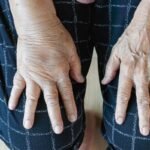Hand eczema caused by cold is common during the winter months. When temperatures drop and the weather is dry, there’s a greater tendency to experience dry skin , which can lead to the development of eczema or dermatitis .
The skin dries out in the cold because it can alter its skin barrier, which plays a key role in protecting the body from external aggressions.
Another of its main functions is to regulate transepidermal water loss . That is, to prevent excessive evaporation of internal water, maintaining skin hydration and elasticity.
Specifically, dry, cold weather can increase this transepidermal water loss, resulting in dry, irritated, and infection-prone skin.
In the case of hands, they are much more exposed to the environment than other parts of the body and are subject to constant washing.
Hence, during the winter months, the appearance of eczema on the hands due to cold is relatively common.
Additionally, it’s worth keeping in mind that hands don’t have many sebaceous glands, which also makes them more prone to irritation.
What is cold-related hand eczema?
Cold-induced hand eczema is characterized by inflammation of the skin on this part of the body.
This results in dry , red, rough, scaly, and cracked hands . Thickened skin is also common, as well as tightness, itching, and even pain.
This type of eczema tends to be chronic. That is, it persists for more than three months or recurs two or more times a year, despite proper treatment and adherence.
Occasionally, hand dermatitis can present with small, fluid-filled blisters. If these appear in recurring outbreaks, it is known as dyshidrotic eczema.
This is especially common among young people, tends to worsen in the cold, and has been linked to excessive sweating on the palmar surface.
Hand eczema caused by cold most often affects the palms, followed by the fingers and the back of the hand.
If it occurs primarily on the fingers, it is known as pulpitis. This type of dermatitis is characterized by extreme dryness that usually begins at the pads of the fingers and can eventually spread.
In other cases, the lesions are well-circumscribed and take on an oval or rounded shape. This is called nummular eczema.
In the case of dry and cracked hands, the fissures can be an entry route for pathogenic microorganisms and cause a skin infection .
In addition, itching often causes scratch wounds, which can also become infected.
People with cold-related hand dermatitis can see their quality of life significantly affected.
How to prevent hand dermatitis from cold
The discomfort caused by cold-related hand eczema can have a significant impact on domestic, psychological, social, and occupational health.
Especially when it’s chronic and/or severe. That is, it’s extensive, long-standing, or recurrent, and is associated with fissures, severe lichenification, and infiltration.
Furthermore, its treatment is complex, as it can be aggravated by other factors. This is why it is so important to prevent cold-related hand dermatitis during the winter months.
To do so, it is advisable to follow the following preventive measures.
1) Protect your hands with gloves
In cold, dry climates, gloves should always be worn outdoors to prevent skin from drying out and cracking.
It is also recommended to wear vinyl or nitrile gloves for cleaning tasks involving water or irritating substances (soaps, detergents, bleach, etc.), as well as for food preparation.
It is important to wear cotton gloves underneath, as sweating can make eczema worse.
Cotton gloves are also recommended for household tasks such as dusting.
In the workplace, there are special gloves for handling substances that can penetrate vinyl gloves.
2) Apply cream for dry hands
Moisturizing cream or emollient should be applied to your hands as often as necessary, but at least after each wash and before going to bed.
If it is a treatment for intensive eczema, it can be applied under occlusion with the use of gloves.
The best creams for dry hands are those that contain moisturizers and are rich in lipids, as they are the most effective. Specifically, they have been shown to promote healing and prevent new outbreaks of hand eczema.
For this reason, you should look for products that contain ingredients such as squalane, hyaluronic acid, lactic acid, and urea.
It is important that they also have a composition similar to the skin barrier, thus allowing its repair.
Furthermore, they must be specially formulated for sensitive hands, avoiding potential allergens, such as preservatives most associated with allergic reactions.
Another important factor is that they have a good galenic effect. That is, they must be pleasant to apply. This will promote treatment adherence.
This means that they are products that are absorbed quickly without leaving greasy residue.
Petroleum jelly or other occlusive creams create a physical barrier that prevents the skin from losing moisture and protects it from irritants. However, their cosmetic properties are not optimal.
Furthermore, when applied to inflamed skin, they can aggravate hand eczema. Therefore, they should only be used on healthy skin.
3) Limit risk factors
The causes of eczema can be multifactorial. Beyond the climate, in winter, other factors can promote or worsen cold-related hand dermatitis. Among them is dry air due to heating.
To counteract the dry air caused by heating, humidifiers can be used. However, they must be properly maintained.
Something to avoid is direct contact with radiators, braziers, or other heat sources.
Handwashing should also be limited. If required for professional reasons, it is preferable to use alcohol-based hand sanitizers, as they are less irritating than soap and water.
Handwashing should be done with warm water and avoid strong or perfumed soaps. Rings should also be removed beforehand, as they can retain moisture and soap.
When drying, it’s best to do so by gently patting with a towel or paper towel, rather than rubbing your hands together.
4) Take extreme precautions with sensitive skin
People with atopic-prone skin are more susceptible to hand eczema due to cold in winter.
For this reason, in the case of atopic dermatitis in adults, preventive measures must be taken to the extreme.
Likewise, it’s important to keep in mind that, with age, the skin’s barrier function weakens. Consequently, older skin is more prone to dry skin and eczema.
If a substance is suspected of causing an allergic reaction ( allergic dermatitis ), allergy testing is recommended. If the results are positive, products containing that substance should be avoided.
Also, people who experience sweaty hands due to anxiety or palmar hyperhidrosis for another reason are at greater risk of developing dyshidrotic eczema, which may worsen in the cold.
Dry hands often cause tightness and itching, triggering the urge to scratch.
Furthermore, many times this ends up becoming a habit or something that is done unconsciously due to nervousness, so it is important to know how to relieve itching on the body due to stress .
Finally, some professions are at higher risk of suffering from cold-related hand eczema in winter because they are more exposed to other triggering factors. This is mainly due to frequent hand washing or contact with irritating substances.
This is the case for domestic workers, healthcare workers, food handlers, hairdressers, construction workers, engineering workers, and electronics workers.
5) Treat the first symptoms early
To prevent cold-related hand eczema from worsening or becoming chronic, it is essential to detect the early symptoms of dermatitis.
If the above skin care measures are insufficient, specific treatment should be initiated.
These often include the use of topical corticosteroids for flares and calcineurin inhibitors as a maintenance regimen.
In cases of superinfection, topical antibiotics and antiseptics such as chlorhexidine are effective. However, they carry the risk of causing allergic contact dermatitis, so oral antibiotics are sometimes prescribed.
If no improvement is experienced, oral corticosteroids are usually recommended.
If these fail to control symptoms, the next line of treatment is alitretinoin and phototherapy.
Other systemic treatments such as cyclosporine, methotrexate, azathioprine, and mycophenolate mofetil may also be recommended.





















+ There are no comments
Add yours